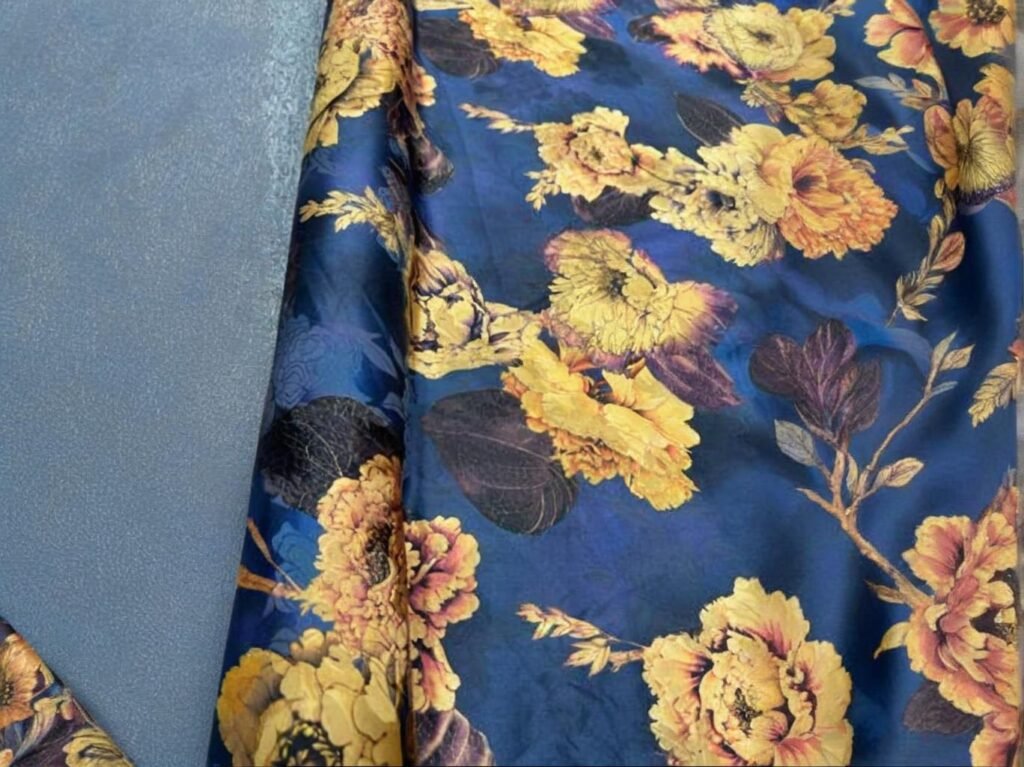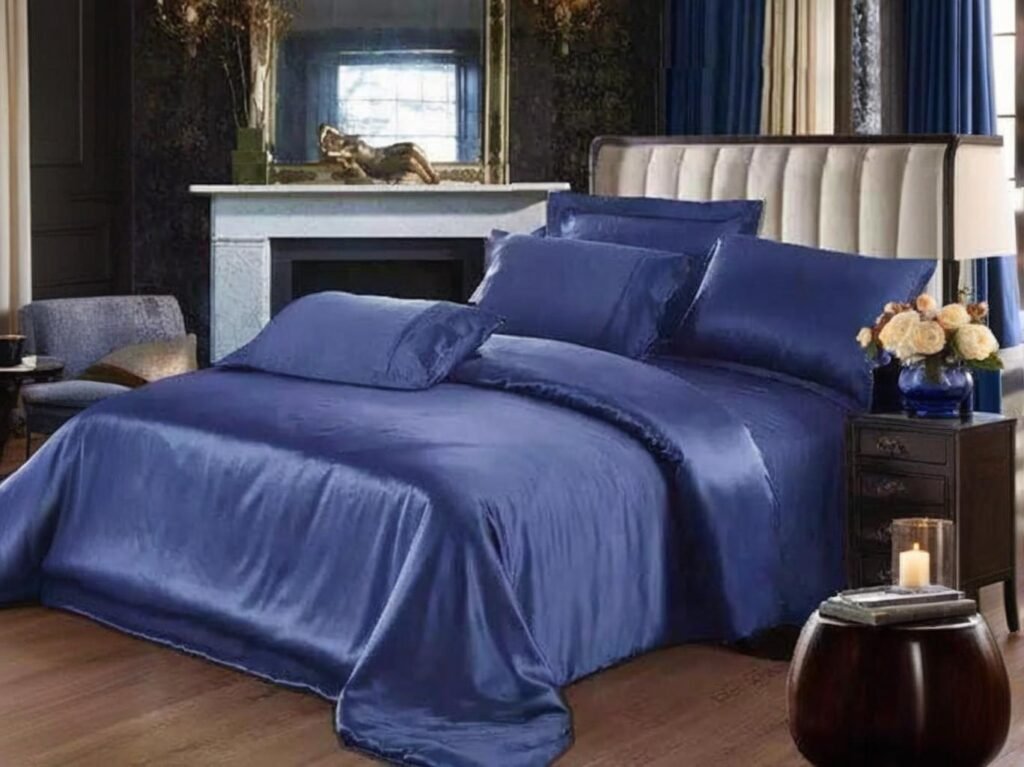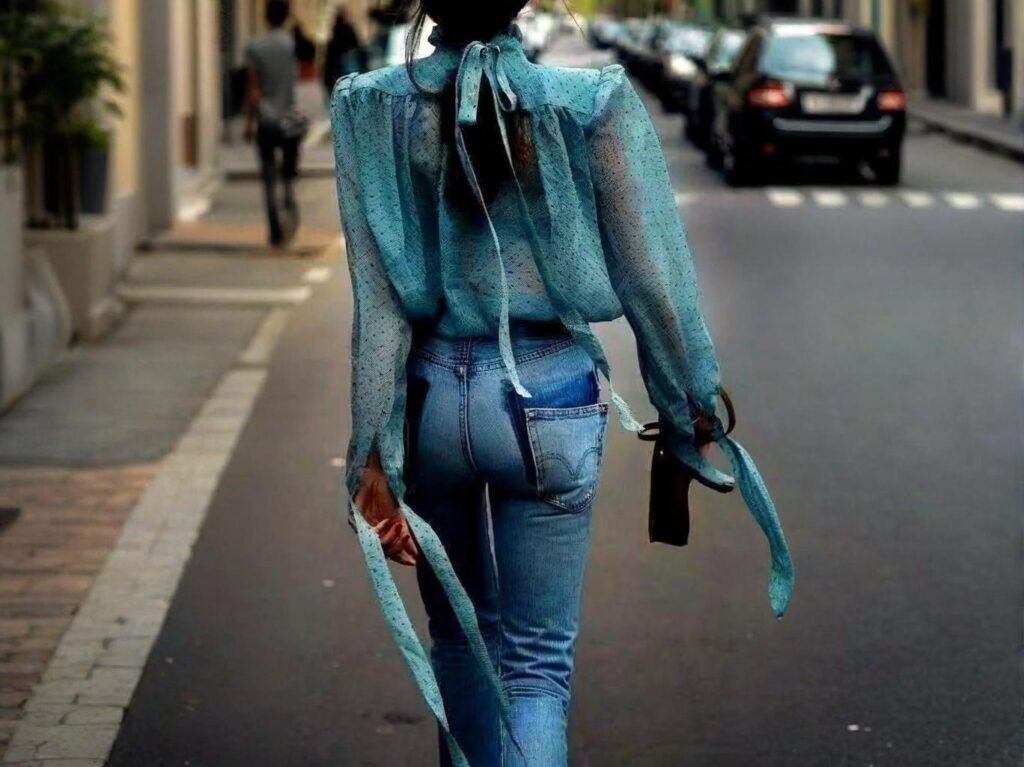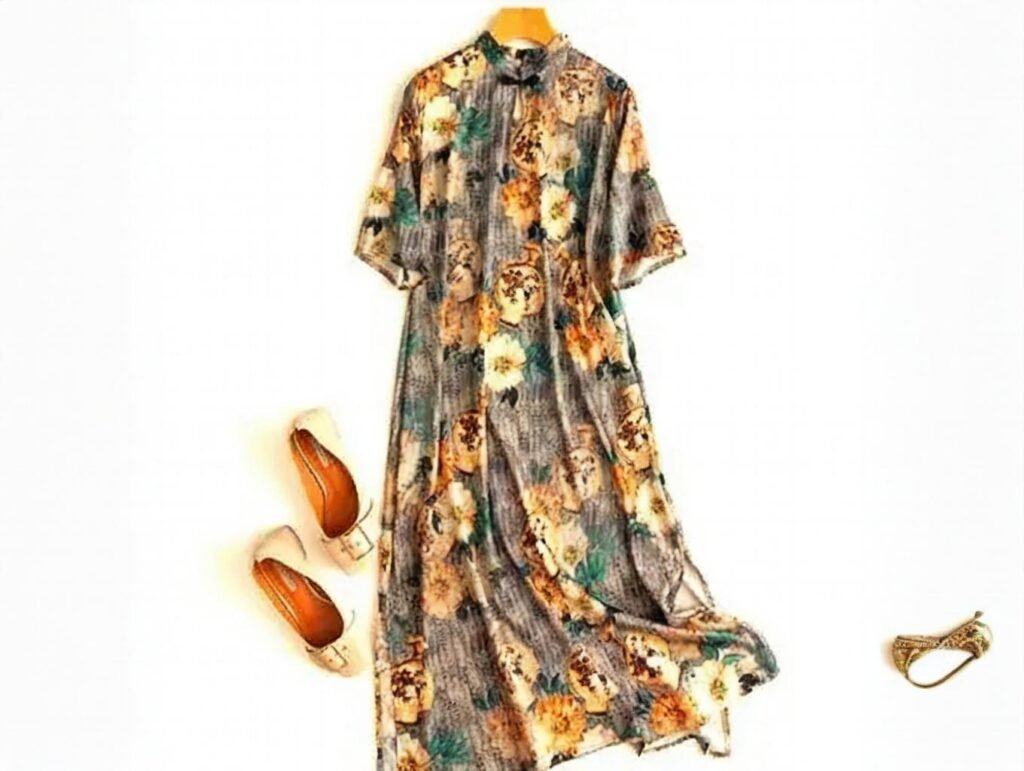Silk sarees have long been regarded as a symbol of elegance, sophistication, and cultural heritage, particularly in South Asia. With the increasing demand for luxury textiles, silk sarees have secured a strong position in the global export market. Today, several variants of silk sarees cater to diverse consumer preferences, each offering unique textures, designs, and weaving techniques. Whether it’s for traditional occasions or modern fashion statements, the rich diversity of silk saree types appeals to both heritage-conscious and fashion-forward buyers worldwide. Silk sarees come in a variety of types, such as Kanjeevaram, Banarasi, and Mysore Silk, each with distinctive weaving techniques and cultural significance. These sarees dominate global export markets due to their quality, craftsmanship, and luxurious appeal.
The growth of the global silk saree market is driven not only by traditional appreciation for these textiles but also by the modern demand for high-quality, sustainable fabrics. As technology and design continue to evolve, silk sarees remain a staple in the fashion and textile industry. Let’s take a deep dive into the key types of silk sarees and their importance in global trade.
What Are the Different Types of Silk Sarees and Their Origins?

Silk sarees are classified into various types based on the silk variety, weaving techniques, and the region where they are produced. The most popular silk saree variants include Kanjeevaram, Banarasi, Mysore Silk, Patola, and Tussar silk sarees, each carrying a rich cultural heritage and distinctive production methods. Silk sarees come in many types, including Kanjeevaram, Banarasi, and Mysore Silk. These sarees are defined by their weaving styles, materials, and regional significance, each appealing to different market demands.
Different Types of Silk Sarees and Their Unique Features
1. Kanjeevaram Silk Sarees
- Originating from Kanchipuram, Tamil Nadu, Kanjeevaram sarees are made from mulberry silk and are known for their heavier texture and golden borders.
- They are traditionally used for weddings and special occasions. The intricate contrast border designs are a hallmark of Kanjeevaram sarees.
- Popular globally due to their luxurious appeal and intricate craftsmanship, Kanjeevarams are a major export item.
2. Banarasi Silk Sarees
- Hailing from Varanasi, Uttar Pradesh, Banarasi silk sarees are made with fine silk threads and feature intricate brocade designs.
- Known for their elaborate gold work and rich patterns, these sarees are highly sought after for ceremonial events and festivals.
- They are commonly exported due to their unique designs and cultural significance in Indian heritage.
3. Mysore Silk Sarees
- Produced in Mysore, Karnataka, these sarees are made from pure silk and are famous for their soft texture and vibrant, bold colors.
- They are distinguished by their delicate zari work (golden thread) and are a popular choice for wedding sarees.
- Mysore silk sarees are highly appreciated for their fine finish and quality, making them a top export item.
4. Patola Silk Sarees
- Patola sarees, made in Surat, Gujarat, are handwoven and feature double ikat patterns, known for their complexity and vibrancy.
- These sarees are extremely expensive and are traditionally worn by the elite during important ceremonies.
- The intricate designs and luxurious feel make Patola silk sarees a popular export to high-end international markets.
5. Tussar Silk Sarees
- Tussar silk is produced from wild silkworms, particularly in Jharkhand, Bihar, and West Bengal. The fabric is naturally coarse and textured, making it ideal for casual and festive wear.
- Tussar sarees are popular for their natural, earthy colors and their unique rustic appeal, which has led to increasing demand in the export markets for both luxury and sustainable fashion.
Silk Saree Types Comparison
| Type | Origin | Features | Ideal for |
|---|---|---|---|
| Kanjeevaram | Tamil Nadu | Heavy texture, gold borders | Weddings, special occasions |
| Banarasi | Varanasi | Intricate brocade, gold work | Ceremonial events, festivals |
| Mysore Silk | Karnataka | Soft texture, vibrant colors | Weddings, festive events |
| Patola | Gujarat | Double ikat, intricate designs | Elite events, special occasions |
| Tussar Silk | Jharkhand, Bihar | Coarse texture, earthy colors | Casual, eco-friendly fashion |
Which Silk Saree Variants Are Most Popular in International Markets?
When it comes to international markets, certain silk saree variants stand out due to their unique qualities, luxurious feel, and cultural significance. Kanjeevaram, Banarasi, and Mysore silk sarees are often the most sought-after types in global trade, driven by global demand for traditional fabrics, exquisite craftsmanship, and cultural heritage.
Kanjeevaram, Banarasi, and Mysore silk sarees dominate international markets due to their luxurious quality, intricate designs, and cultural significance, making them highly desirable in global fashion.
These silk sarees appeal to a wide range of consumers, from those seeking authentic traditional fabrics to those desiring high-quality luxury textiles. Let’s explore why these variants are leading the export markets.
Why Kanjeevaram, Banarasi, and Mysore Silk Sarees Dominate Global Markets
1. Kanjeevaram Silk Sarees’ Global Appeal
- Kanjeevaram sarees are recognized worldwide for their luxurious feel, rich colors, and handwoven craftsmanship.
- Their global appeal is largely driven by the distinctive borders and opulent designs, making them a favorite among consumers seeking traditional yet fashionable options for special events.
- The demand for Kanjeevaram silk has grown significantly in Western markets due to increased interest in ethnic wear and wedding apparel.
2. Banarasi Silk Sarees as a Luxury Export
- Banarasi sarees are synonymous with luxury and elegance, appealing to international buyers who value intricate craftsmanship and exclusive designs.
- Their golden zari work and complex brocade patterns make them ideal for high-end fashion markets in Europe and the Middle East, where consumers appreciate high-quality cultural textiles.
- The rise of cultural fashion and bridal markets in the West has boosted demand for Banarasi silk.
3. Mysore Silk Sarees: Softness and Luxury
- Mysore silk is prized for its softness, vibrancy, and shine, making it an ideal choice for both traditional and contemporary fashion.
- The combination of high-quality silk, intricate zari work, and vivid colors makes Mysore silk sarees popular with luxury consumers, especially in Asian markets and high-end bridal collections globally.
- Their reputation for quality craftsmanship has made Mysore silk sarees a staple in the export market.
Export Trends Chart
| Saree Type | Target Markets | Popularity Drivers | Export Trends |
|---|---|---|---|
| Kanjeevaram | USA, UK, Middle East | Luxurious feel, intricate designs | Wedding markets, bridal wear |
| Banarasi | Europe, Middle East | Gold brocade, exclusivity | High-end fashion, bridal wear |
| Mysore Silk | Asia, USA, UK | Soft texture, vibrant colors | Luxury markets, fashion houses |
SzoneierFabrics partners with high-end Indian designers to supply Banarasi silk sarees for the European wedding market. By providing customized designs and fast turnarounds, the company has increased its export volume by 30% over the past year.
How Is Mulberry Silk Used in the Production of Sarees?

Mulberry silk, derived from the Bombyx mori silkworm, is widely regarded as the highest quality silk in the world, making it the preferred choice for many silk saree producers. Known for its smooth texture, brilliant sheen, and durability, mulberry silk is an essential component in crafting luxurious sarees like Kanjeevaram, Banarasi, and Mysore silk sarees. The use of mulberry silk ensures that the sarees are not only visually stunning but also durable and long-lasting, which is vital for high-end fashion and bridal collections. Mulberry silk is the preferred choice in silk saree production due to its smooth texture, brilliant sheen, and durability, making it ideal for luxury sarees like Kanjeevaram and Banarasi.
In the context of global trade, mulberry silk sarees have gained popularity in international markets due to their exceptional quality and appeal, making them a dominant force in the export market for luxury fabrics.
Why Mulberry Silk Is Ideal for Saree Production
1. Silk Fibers and Quality
- Mulberry silk fibers are the longest and finest of all silk varieties, giving the fabric its unique smoothness and luxurious feel
- The fiber length contributes to the durability and strength of the sarees, ensuring they are less prone to wear and tear, making them ideal for high-end and frequent wear
2. Brightness and Sheen
- The natural shine of mulberry silk adds to the vibrancy of sarees, making them particularly attractive in both traditional and modern designs
- Sarees made with mulberry silk are more likely to maintain their rich color and sheen over time, even after repeated use or cleaning
3. Eco-friendly and Sustainable
- Mulberry silk is produced with a focus on sustainability, with silkworms being raised in controlled environments where they feed on mulberry leaves
- The controlled farming process reduces the environmental footprint of silk production, making it a more sustainable choice for ethical fashion brands
4. Durability and Comfort
- Mulberry silk sarees are not only durable but also breathable and comfortable to wear in various weather conditions
- The fabric’s moisture-wicking properties ensure comfort during long hours of wear, especially for bridal sarees and ceremonial occasions
Mulberry Silk Advantages Table
| Benefit | Mulberry Silk | Other Silk Types (e.g., Tussar, Eri) |
|---|---|---|
| Fiber Quality | Long, fine fibers for smooth texture | Shorter fibers, rougher texture |
| Sheen | High natural shine | Lower sheen, less glossy |
| Durability | Strong, resistant to wear and tear | Less durable |
| Sustainability | Eco-friendly, controlled farming | Often more wild or less controlled |
| Comfort | Breathable, moisture-wicking | Less breathable |
A luxury bridal collection in the US sourced mulberry silk Kanjeevaram sarees for their exclusive wedding line. The high-quality, smooth texture of the silk and its long-lasting sheen helped the collection receive praise from international customers, contributing to a 20% increase in sales.
What Is the Role of Handloom in Silk Saree Production?
Handloom weaving plays a critical role in the traditional production of silk sarees, especially in regions like Kanchipuram and Varanasi, where craftsmanship has been passed down through generations. Handloom woven sarees are highly valued for their intricate designs, artisanal quality, and unique patterns, making them a popular choice for both local markets and international exports. The slow, careful process of hand weaving gives these sarees a distinct texture and personal touch that machine-made fabric simply cannot replicate. Handloom weaving plays a significant role in creating intricate, high-quality silk sarees, valued for their craftsmanship, traditional designs, and artisanal appeal, making them highly sought after in international markets.
Handloom sarees not only support the preservation of traditional techniques but also offer a unique luxury product that appeals to consumers who appreciate craftsmanship and ethnic fashion.
The Importance of Handloom in Silk Saree Production
1. Handloom vs. Powerloom
- Handloom weaving is a manual process, involving skilled artisans who weave the silk thread on looms to create intricate patterns
- Powerlooms, on the other hand, are mechanized and typically produce sarees much faster, but they lack the personal touch and detail of handwoven fabrics
- The slow production process of handlooms results in higher quality, with each piece being a unique creation
2. Artisan Skill and Tradition
- The handloom industry provides a livelihood to artisans in rural areas, preserving traditional skills and techniques that have been passed down for centuries
- Handwoven sarees often feature intricate motifs and border designs, which are more complex and detailed compared to machine-made alternatives
- This craftsmanship results in higher demand for authentic, handwoven silk sarees in global export markets, especially from consumers who value artisan-made textiles
3. Luxury Appeal and Global Demand
- Handloom silk sarees, with their superior quality, unique designs, and connection to heritage, hold significant appeal in high-end and luxury fashion markets
- International buyers often seek handwoven sarees for cultural authenticity and exclusivity, making them highly sought after for luxury bridal collections and premium fashion lines
4. Supporting Sustainable Fashion
- The handloom process is also more eco-friendly than industrialized weaving, as it requires less electricity and generates fewer carbon emissions
- Handloom sarees support sustainability by promoting slow fashion and minimizing waste, which aligns with global trends in ethical fashion
Handloom vs Powerloom Impact Table
| Feature | Handloom Silk Sarees | Powerloom Silk Sarees |
|---|---|---|
| Production Speed | Slow, artisanal process | Fast, mechanized |
| Quality | High, with unique, detailed designs | Standardized, less intricate |
| Craftsmanship | High, skilled artisans | Lower, less detailed patterns |
| Sustainability | Eco-friendly, low energy consumption | Higher energy consumption |
| Market Appeal | Luxury, premium, culturally significant | Mass-market, less exclusive |
A European luxury brand sourced handloom woven Banarasi silk sarees for a limited edition collection. The intricate handwoven gold brocade and unique patterns attracted global buyers, increasing the brand’s presence in premium international markets.
How Does the Dyeing Process Affect the Quality of Silk Sarees?

The dyeing process is crucial in determining the color quality and appearance of silk sarees. The vibrancy, consistency, and longevity of the colors are directly influenced by the dyeing techniques used in the production. Various methods, including hand dyeing, digital dyeing, and eco-friendly dyeing, impact the final product differently. For luxury and high-end silk sarees, achieving rich, long-lasting colors is essential to maintaining their premium appeal in international markets. The dyeing process significantly impacts silk saree quality by influencing color richness, color retention, and fabric texture. Techniques like eco-friendly dyeing are increasingly popular in sustainable fashion.
As consumers become more eco-conscious, there’s a growing demand for environmentally friendly dyeing processes that minimize the impact on both the environment and the fabric. These methods are shaping the future of silk saree production, especially in markets with high demand for sustainable fashion.
How Dyeing Methods Impact Silk Saree Quality
1. Traditional Hand Dyeing
- Hand dyeing involves manual processes, where artisans use natural or synthetic dyes to color silk. This method provides rich, unique colors and allows for more personalization in design.
- However, the process can be time-consuming and less consistent than machine dyeing.
2. Digital Dyeing
- Digital dyeing uses print technology to apply dye directly to fabric, offering high precision, intricate designs, and color accuracy.
- This method is faster and more flexible, allowing for shorter lead times and custom designs but may lack the rich texture of traditional dyeing.
3. Eco-Friendly Dyeing
- As sustainability becomes a priority, eco-friendly dyeing methods using natural dyes or waterless dyeing techniques are gaining traction.
- Eco-friendly dyes are made from plant-based materials, ensuring the reduction of toxic chemicals and water usage in the production process.
4. Color Fastness
- One of the most critical aspects of dyeing is color fastness, which refers to how well the fabric retains its color after washing and wearing.
- Sarees dyed using superior techniques like reactive dyeing or eco-friendly dyes tend to have better color retention, making them more desirable in international markets.
Dyeing Process Comparison
| Dyeing Method | Characteristics | Pros | Cons |
|---|---|---|---|
| Hand Dyeing | Manual, traditional process | Rich, unique colors, customization | Time-consuming, inconsistent |
| Digital Dyeing | Precision dyeing using digital technology | High accuracy, fast production | May lack richness in texture |
| Eco-Friendly Dyeing | Uses natural, plant-based dyes | Sustainable, low environmental impact | May have limitations in color range |
| Reactive Dyeing | Uses chemical reactions to fix dye to fiber | Long-lasting, vibrant colors | Requires careful handling of chemicals |
SzoneierFabrics recently adopted eco-friendly dyeing techniques for its silk saree production, using plant-based dyes and waterless dyeing methods. This move has not only improved the sustainability of their production process but has also attracted eco-conscious brands looking to meet ethical fashion standards.
What Are the Key Trends in Silk Saree Exports in 2025?
As the global silk saree market evolves, several key trends are shaping its future. These trends include a rise in eco-consciousness, demand for customization, and the influence of global fashion. In 2025, buyers and consumers will be more focused on sustainable sourcing, unique designs, and ethically produced fabrics. The silk saree export market is seeing trends like sustainable sourcing, customization demand, and a shift towards luxury eco-friendly fabrics in 2025, aligning with the growing focus on ethical fashion.
With a growing focus on sustainable textiles, transparency in sourcing, and innovative production methods, the silk saree export market is becoming more dynamic and responsive to global fashion demands.
Silk Saree Export Trends for 2025
1. Sustainable and Ethical Sourcing
- International buyers are increasingly prioritizing suppliers who source eco-friendly silk and adhere to ethical labor practices.
- Fair Trade, GOTS, and OEKO-TEX certifications are becoming crucial for gaining consumer trust in Western and Asian markets.
2. Customized Designs and Personalization
- Customization is a growing demand in the silk saree market, with consumers seeking unique colors, designs, and custom weaving patterns.
- Technology such as digital printing is enabling faster and more precise customization, while also allowing for small-batch orders to cater to niche markets.
3. Rise in Eco-Conscious Consumer Demand
- Sustainability is one of the top priorities for consumers, especially in Western markets where eco-friendly fashion is gaining momentum.
- Silk sarees made with organic mulberry silk, eco-friendly dyes, and waterless dyeing techniques are increasingly sought after.
4. Influence of International Fashion
- Global fashion trends are influencing the design and aesthetic of silk sarees, with modern interpretations of traditional designs gaining popularity in both bridal fashion and ethnic wear collections.
- Silk sarees are becoming part of global fashion lines, as they appeal to high-end consumers who value luxury and sustainable fashion.
Key Export Market Trends
| Trend | Impact on Silk Sarees | Buyer Focus |
|---|---|---|
| Sustainable Sourcing | Increased demand for eco-friendly silk | Certifications (GOTS, OEKO-TEX) |
| Customization | Need for personalized designs | Digital printing, small batch |
| Eco-Conscious Consumer Demand | Rise of sustainable fabrics in luxury markets | Eco-friendly sourcing, green fashion |
| Global Fashion Influence | Adaptation of silk sarees in modern styles | High-end fashion, bridal collections |
A European luxury retailer recently increased its imports of GOTS-certified silk sarees to meet growing demand for sustainable bridal wear. By offering customized designs and eco-friendly fabrics, they attracted a 15% increase in sales from eco-conscious consumers in 2025.
How Do Silk Saree Designs Reflect Regional Traditions?

Silk sarees are a quintessential part of India’s cultural heritage, with each region having its own distinct style, color, and design pattern. These sarees are not only garments but also reflect the artistic traditions, cultural symbolism, and craftsmanship of the regions where they are produced. From the elaborate brocade work of Banarasi silk to the vibrant geometrical patterns of Patola, silk saree designs serve as a visual representation of a region’s history and traditions. Silk saree designs are deeply influenced by regional traditions and cultural heritage. Each variant showcases the unique craftsmanship and artistic values of the region it originates from, such as Banarasi and Patola.
For international buyers, understanding these regional distinctions is key to selecting silk sarees that resonate with their target audience’s taste and preferences. Sarees with unique regional designs are highly sought after for their cultural significance and traditional appeal.
Regional Design Differences and Their Influence on Global Demand
1. Banarasi Silk Saree Designs
- Originating from Varanasi, Uttar Pradesh, Banarasi sarees are known for their intricate gold brocade and floral patterns, often depicting themes from Indian mythology and nature.
- These sarees are heavily influenced by the Mughal and Persian design traditions, which are reflected in their luxurious and regal aesthetic.
- Banarasi sarees have a timeless appeal in global markets, particularly in wedding wear, where the golden brocade symbolizes prosperity and elegance.
2. Kanjeevaram Silk Saree Designs
- The Kanjeevaram saree from Tamil Nadu is renowned for its bold and vibrant contrasting borders, often incorporating temple motifs, geometric designs, and floral patterns.
- These sarees use intricate silk weaving techniques, which often involve golden zari work that enhances the fabric’s luxury appeal.
- Global demand for Kanjeevaram sarees is increasing, especially among brides and fashion-forward buyers who appreciate the bold color contrasts and opulent designs.
3. Patola Silk Saree Designs
- Patola sarees from Gujarat are known for their double ikat weaving technique, where both the warp and weft threads are tie-dyed before weaving.
- This results in complex geometric designs that are admired for their precision and vibrancy.
- Patola sarees are often regarded as one of the most exclusive and luxurious sarees in the world, and they have found a growing market in premium fashion and luxury exports.
4. Mysore Silk Saree Designs
- Mysore silk sarees are characterized by intricate zari work and bold, vibrant colors, often featuring motifs inspired by royal iconography and traditional Indian symbols.
- These sarees are highly popular in global markets, especially for wedding collections, because of their delicate weaving and elegant appeal.
- The appeal of Mysore silk lies in its luxury feel and unique craftsmanship, making it a favorite for high-end bridal collections globally.
| Silk Saree Type | Region | Key Design Features | Global Appeal |
|---|---|---|---|
| Banarasi | Varanasi, Uttar Pradesh | Intricate brocade, floral and mythological patterns | Wedding wear, luxury markets |
| Kanjeevaram | Tamil Nadu | Bold color contrasts, temple motifs, geometric designs | Brides, fashion-forward buyers |
| Patola | Gujarat | Double ikat, geometric patterns | Luxury fashion, exclusive markets |
| Mysore Silk | Karnataka | Zari work, royal motifs, vibrant colors | Bridal wear, high-end collections |
A luxury fashion house based in London has recently collaborated with Indian weavers to source Banarasi silk sarees for their exclusive bridal collection. The sarees feature golden brocade and floral patterns, drawing heavily from Indian heritage while incorporating modern touches for international markets.
What Should Buyers Consider When Sourcing Silk Sarees for Export?
When sourcing silk sarees for export, buyers must consider various factors to ensure the quality, authenticity, and appeal of the fabric. Key considerations include certifications, sourcing methods, fabric quality, and supplier reputation. Given the luxury status of silk sarees, buyers should ensure they are partnering with reliable suppliers who maintain strict quality controls and ethical sourcing practices. Buyers should focus on sourcing certified silk sarees with high-quality fabrics and ensure reliable suppliers offer authentic designs that align with global demand for luxury and eco-conscious products.
Key Considerations for Sourcing Silk Sarees for Export
1. Supplier Reputation and Transparency
- Reputable suppliers should provide traceability of the fabric’s origins and production process, ensuring the sarees are made from genuine silk and ethical labor.
- It’s important to verify supplier certifications (e.g., GOTS, OEKO-TEX, Fair Trade) to guarantee that the sarees meet global standards for sustainability and quality.
2. Quality Control and Consistency
- Buyers should work with suppliers that have consistent quality control processes in place to ensure each batch of silk sarees is free from defects and meets the required design standards.
- Quality tests for colorfastness, fabric strength, and pattern accuracy are essential before bulk orders are placed.
3. Ethical and Sustainable Practices
- Given the increasing consumer demand for sustainable fashion, it’s critical for buyers to source silk sarees from eco-conscious manufacturers who use sustainable dyeing methods, organic silks, and fair labor practices.
- Certification bodies like Fair Trade or GOTS can provide assurance that the sarees are produced under ethical conditions.
4. Market Trends and Consumer Preferences
- Understanding market trends and consumer preferences is key when sourcing silk sarees for export. Preferences vary by region, with some markets favoring traditional designs and others preferring contemporary adaptations.
- It’s crucial for buyers to keep up-to-date with global fashion trends, cultural preferences, and regional demand for specific saree variants.
| Consideration | Key Focus | Action Required |
|---|---|---|
| Supplier Reputation | Ethical sourcing, quality control | Verify certifications and audit reports |
| Quality Control | Consistency in design, fabric strength | Conduct quality tests before ordering |
| Ethical Practices | Fair labor, sustainable production | Ensure certifications like Fair Trade or GOTS |
| Consumer Preferences | Modern vs. traditional designs | Stay updated on market trends |
SzoneierFabrics has been instrumental in meeting the growing demand for sustainable silk sarees. By sourcing GOTS-certified silk and handwoven sarees, they have gained a strong foothold in global luxury markets. This has helped boost their export volume by 25% in the past year, as buyers increasingly seek ethically produced and sustainable silk fabrics.
The global silk saree market continues to thrive as it reflects a blend of tradition and modern demands for luxury, sustainability, and ethical sourcing. By understanding the various types of silk sarees, the intricate design techniques, and the growing demand for sustainable and ethical fabrics, buyers can make informed decisions when sourcing silk sarees for export. As the market for silk sarees evolves, SzoneierFabrics stands ready to provide high-quality, certified silk sarees that meet both traditional craftsmanship and modern sustainability standards.
Contact SzoneierFabrics today for custom silk saree solutions, including free samples, and start your journey to premium silk fabric sourcing with confidence.

